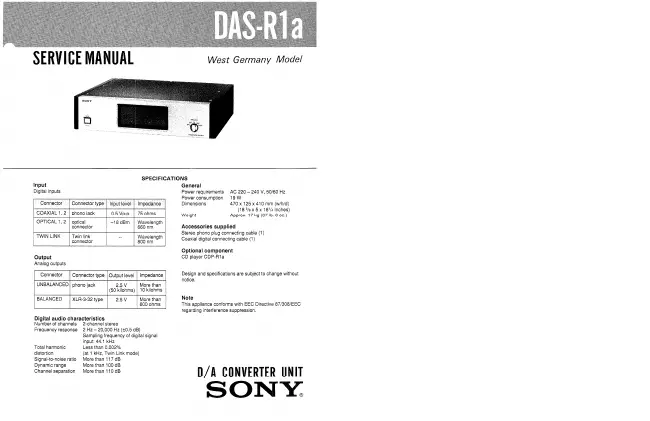The DAS-Rla is a D/A
Converter for use with the CDP-Rla CD Player, as a part of separate-type
CD player system.
The
DAS-R1 a converts the digital signai picked up from the compact disc by the CDP-R1 a into an analog (audio) signal. Using the Twin Link-S system, the dock signal and data signal are transmitted separately between the
DAS-R1a and the CDP-R1a.
In addition, the
DAS-R1a is designed to accept digital signais from a DBS (Direct Broadcasting Satellite) tuner, a DAT (Digital Audio Tape) deck, etc.
Pulse D/A converter completely free of non-linear distortion, glitches, zero-cross distortion
Conventional D/A converters only produce sound in step-size waves; the waves are rounded through the fow-pass fifter, and converted to an analog (audio) signal.
The pulse D/A converter of the DAS-Rl a sends either a “high" signal (current on) or a “low" signal (current off). Complicated waveforms -music- is expressed by the way in which the pulse density is varied. The pulse D/A converter is theoretically free of the non-linear distortion, glitches, and zero-cross distortion that are unavoidable with conventional D/A converters. It lends a natural, warm character to the music.
High performance LSI with high sampling speed master clock and superior calculation method
The performance of the pulse D/A converter is determined by the pulse frequency and the way in which they are calculated. The LSI adopted in the DAS-Rla achieves a maximum master clock operating frequency of as high as 50 MHz. This is two times higher than that of conventional high-speed C-MOS chips. Puises are calculated by a unique Sony Extended Noise Shaping method to generate the high-density pulse train.
Cauer-tow-pass filter conveys all musical Information without delay
The Cauer-low-pass filter instantly conveys all musical information for ali bandwidths, with superior qualify and rippfe accuracy, echo and rejection characteristics.
At the same time, the sound resolution greatly increases with the improved S/N characteristics.
Player, as a part of separate-type
CD player system.
The
DAS-R1 a converts the digital signai picked up from the compact disc by the CDP-R1 a into an analog (audio) signal. Using the Twin Link-S system, the dock signal and data signal are transmitted separately between the
DAS-R1a and the CDP-R1a.
In addition, the
DAS-R1a is designed to accept digital signais from a DBS (Direct Broadcasting Satellite) tuner, a DAT (Digital Audio Tape) deck, etc.
Pulse D/A converter completely free of non-linear distortion, glitches, zero-cross distortion
Conventional D/A converters only produce sound in step-size waves; the waves are rounded through the fow-pass fifter, and converted to an analog (audio) signal.
The pulse D/A converter of the DAS-Rl a sends either a “high" signal (current on) or a “low" signal (current off). Complicated waveforms -music- is expressed by the way in which the pulse density is varied. The pulse D/A converter is theoretically free of the non-linear distortion, glitches, and zero-cross distortion that are unavoidable with conventional D/A converters. It lends a natural, warm character to the music.
High performance LSI with high sampling speed master clock and superior calculation method
The performance of the pulse D/A converter is determined by the pulse frequency and the way in which they are calculated. The LSI adopted in the DAS-Rla achieves a maximum master clock operating frequency of as high as 50 MHz. This is two times higher than that of conventional high-speed C-MOS chips. Puises are calculated by a unique Sony Extended Noise Shaping method to generate the high-density pulse train.
Cauer-tow-pass filter conveys all musical Information without delay
The Cauer-low-pass filter instantly conveys all musical information for ali bandwidths, with superior qualify and rippfe accuracy, echo and rejection characteristics.
At the same time, the sound resolution greatly increases with the improved S/N characteristics.
Carefully configured master clock and direct digital sync circuit for jitter-free sound reproduction
The master dock of the crystal oscillator is located almost directly on the pulse D/A converter to provide the purest possible dock signal. Also, a direct sync circuit is provided just ahead of the electronic switch in the last stage of the converter. The sync circuit rearranges the data along with the master clock signal. This ensures crystal-clear, powerful sound reproduction.
Twin Link-S system for improved D/A converter time axis accuracy
The Twin Link-S system adopted in the CDP-R1a and the DAS-Rla improves the time-axis precision, giving completely jitter-free sound reproduction.
The previous Sony separate-type CD piayer and D/A converter, the CDP-R1 and DAS-R1, set new standards for optical interface with the introduction of the “Twin Link System". In this system, the crystal oscillator is located very near the D/A converter which treats waves with the absolute minimum of distortion. In addition, bidirectional interlace lines are provided; one is used to send clock timing information from the converter to the player, and the second is used to send normal data from the player to the converter.
With the development of the logical synchronization circuit and optical devices, (he Twin Link-S system provides jitter-free D/A conversion that ensures crystal clear and powerful sound reproduction. The Twin Link-S system and the conventional Twin Link system are interchangeable.
Multiple terminal configurations for system expansion
The
DAS-R1a has five digital inputs; one Twin-Link optical input, exclusively used for connection to the CDP-RTa. two coaxial digital inputs, and two optical inputs. Each input can be controlled independently from the front panel.
For analog output, an unbaianced-type pin-jack output and a balanced-type XLR output are provided.
